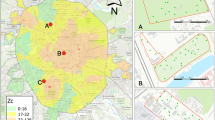Abstract
To get representative soil samples, a sampling method was verified for crop fields in the vicinity of abandoned mine sites. Application of appropriate sampling or analytical methods is very important as it affects the costs, time, and accuracy of the refined investigation of soil contamination. Two-time sampling for each crop field was conducted to verify the reproducibility of a zigzag method for soil sampling. The soil analysis using a portable X-ray fluorescence (pXRF) device was conducted to measure concentrations of metal species in soils, and its results were compared to the extracted concentrations by the Korean Standard Test (KST) for soils. As a result, the determination coefficient (R 2) of linear regression analysis for data obtained by ex situ precise measurement or in situ field screening using pXRF was closely related with the ratio of the extracted concentration by KST to interference-free detection limits (IFDL) of pXRF (designated as KST/IFDL). As the specific metal species had a higher ratio of KST/IFDL, its R 2 was even higher in the field screening tests. However, the slopes of linear regression analysis for most metal species extracted by aqua-regia were close to 1.0 so that extracted concentrations by aqua-regia were similar to the analytical values obtained by pXRF, whereas extraction using a weak acid (0.1 M HCl) had different slopes for soils contaminated with different ranges of concentrations of metal species. Especially Zn showed not only high ratios of KST/IFDL because of aqua regia extraction, but also high determination coefficients. Because of its simple, rapid, and accurate capacities for metal analysis, the pXRF analysis showed high applicability in ex situ precise measurements or in situ field screening of metal analysis. In terms of applicability for regulation, especially in situ pXRF field screening with the zigzag method could be effectively applied to achieve an economical survey by determining hot spots or non-contaminated areas if aqua-regia was applied as the extracting agent in the KST for soils.






Similar content being viewed by others
References
Bernick, M. B., Getty, D., Prince, G., & Sprenger, M. (1995). Statistical evaluation of field-portable X-ray fluorescence soil preparation methods. Journal of Hazardous Materials, 43, 111–116.
EPA. (2007) Field portable X-ray fluorescence spectrometry for the determination of elemental concentrations in soil and sediment (p. 32). Washington, DC: USEPA
Goldstein, S. J., Slemmons, A. K., & Canavan, H. E. (1996). Energy-dispersive X-ray fluorescence methods for environmental characterization of soils. Environmental Science & Technology, 1996(30), 2318–2321.
Hettipathirana, T. D. (2004). Simultaneous determination of parts-per-million level Cr, As, Cd and Pb, and major elements in low contaminated soils using borate fusion and energy dispersive X-ray fluorescence spectrometry with polarized excitation. Spectrochimica Acta Part B, 59, 223–229.
Kalnicky, D. J., & Singhvi, R. (2001). Field portable XRF analysis of environmental samples. Journal of Hazardous Materials, 83, 93–122.
Makinen, E., Korhonen, M., Viskari, E. L., Haapamaki, S., Jarvinen, M., & Lu, L. (2005). Comparison of XRF and FAAS methods in analysing CCA contaminated soils. Water, Air, and Soil Pollution, 171, 95–110.
MOE. (2002). The Korean standard test (KST) methods for soils (p. 225) Gwachun, Kyunggi: Korean Ministry of Environment. (in Korean).
Stallard, M. O., Apitz, S. E., & Dooley, C. A. (1995). X-ray fluorescence spectrometry for field analysis of metals in marine sediments. Marine Pollution Bulletin, 31(4–12), 297–305.
VanCott, R. J., McDonald, B. J., & Seelos, A. G. (1999). Standard soil sample preparation error and comparison of portable XRF to laboratory AA analytical results. Nuclear Instruments & Methods in Physics Research. Section A, 422, 801–804.
Author information
Authors and Affiliations
Corresponding author
Rights and permissions
About this article
Cite this article
Jang, M. Application of portable X-ray fluorescence (pXRF) for heavy metal analysis of soils in crop fields near abandoned mine sites. Environ Geochem Health 32, 207–216 (2010). https://doi.org/10.1007/s10653-009-9276-z
Received:
Accepted:
Published:
Issue Date:
DOI: https://doi.org/10.1007/s10653-009-9276-z




